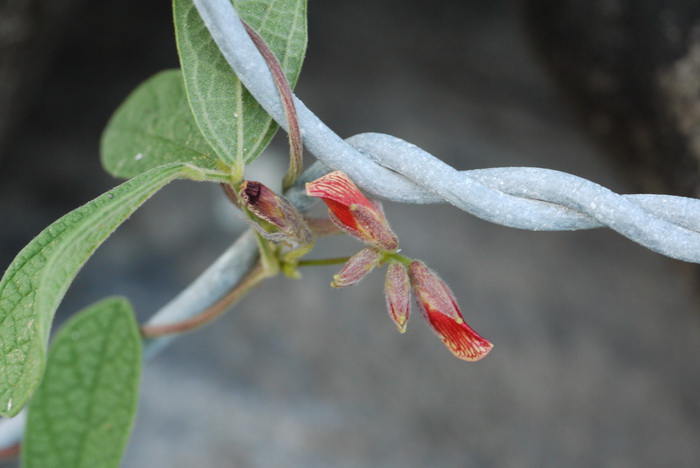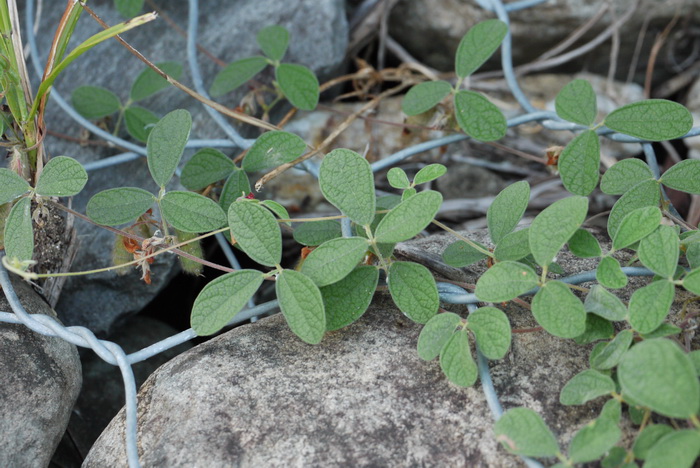蔓草虫豆Cajanus scarabaeoides
中文名(Chinese Name):蔓草虫豆
学名(Scientific Name): Cajanus scarabaeoides (L.) Thouars ex Graham
英文名(English Common Name):showy pigeonpea
别名(Chinese Common Name):
异名(Synonym):Atylosia scarabaeoides (L.) Benth. Stizolobium scarabaeoides (L.)Spreng. Rhynchosia scarabaeoides (L.)DC. Rhynchosia biflora DC. Cantharospermum scarabaeoideum (L.)Baill. Cantharospermum pauciflorum Wight & Arn. Atylosia pauciflora (Wight & Arn.)Druce Dolichos minutus Wight & Arn. Glycine scarabaeoides Hb. Ham. & HBC ex Wallich
科属(Family & Genus):蝶形花科,Fabaceae,木豆属
形态特征(Description):蔓生或缠绕状草质藤本。茎纤弱,长可达2米,具细纵棱,多少被红褐色或灰褐色短绒毛。叶具羽状3小叶;托叶小,卵形,被毛,常早落;叶柄长1-3厘米;小叶纸质或近革质,下面有腺状斑点,顶生小叶椭圆形至倒卵状椭圆形,长1.5-4厘米,宽0.8-1.5 (3)厘米,先端钝或圆,侧生小叶稍小,斜椭圆形至斜倒卵形,两面薄被褐色短柔毛,但下面较密;基出脉3,在下面脉明显凸起;小托叶缺;小叶柄极短。总状花序腋生,通常长不及2厘米,有花1-5朵;总花梗长2-5毫米,与总轴同被红褐色至灰褐色绒毛;花萼钟状,4齿裂或有时上面2枚不完全合生而呈5裂状,裂片线状披针形,总轴、花梗、花萼均被黄褐色至灰褐色绒毛;花冠黄色,长约1厘米,通常于开花后脱落,旗瓣倒卵形,有暗紫色条纹,基部有呈齿状的短耳和瓣柄,翼瓣狭椭圆状,微弯,基部具瓣柄和耳,龙骨瓣上部弯,具瓣柄;雄蕊二体,花药一式,圆形;子房密被丝质长柔毛,有胚珠数颗。荚果长圆形,长1.5-2.5厘米,宽约6毫米,密被红褐色或灰黄色长毛,果瓣革质,于种子间有横缢线;种子3-7颗,椭圆状,长约4毫米,种皮黑褐色,有凸起的种阜。花期9-10月,果期11-12月。
分布(Distribution):产云南、四川、贵州、广西、广东、海南、福建、台湾。常生于海拔150-1500米的旷野、路旁或山坡草丛中。为本属分布最广的一种,东自太平洋上一些岛屿、日本琉球群岛,经越南、泰国、缅甸、不丹、尼泊尔,孟加拉、印度、斯里兰卡、巴基斯坦,直至马来西亚、印度尼西亚、大洋洲乃至非洲均有分布。
用途(Use):叶入药,有健胃、利尿作用。
引自植物志英文版:FOC Vol. 10 Page 230, 232
Cajanus scarabaeoides (Linnaeus) Thouars, Dict. Sci. Nat. 6: 617. 1817.
蔓草虫豆 man cao chong dou | Fabaceae | Cajanus
Dolichos scarabaeoides Linnaeus, Sp. Pl. 2: 720. 1753; Atylosia pauciflora (Wight & Arnott) Druce; A. scarabaeoides (Linnaeus) Bentham; A. scarabaeoides var. argyrophyllus Y. T. Wei & S. K. Lee; Cajanus scarabaeoides var. argyrophyllus (Y. T. Wei & S. K. Lee) Y. T. Wei & S. K. Lee; Cantharospermum pauciflorum Wight & Arnott; C. scarabaeoides (Linnaeus) Baillon; Dolichos medicagineus Roxburgh; D. minutus Wight & Arnott; Rhynchosia biflora Candolle; R. scarabaeoides (Linnaeus) Candolle; Stizolobium scarabaeoides (Linnaeus) Sprengel.
Vines, woody, twining or trailing, to 2 m. Stems slender, ± pubescent. Leaves pinnately 3-foliolate; stipules small, ovate, hairy, usually deciduous; petiole 1-2 cm; stipels absent; petiolules extremely short; leaflets papery or nearly leathery, with glandular spots, sparsely pubescent on both surfaces, denser abaxially, basal veins 3, obviously convex below; terminal leaflet elliptic or obovate-elliptic to obovate, 1.2-4 × 0.8-1.5(-3) cm, apex obtuse or rounded; lateral leaflets smaller, obliquely elliptic to obliquely obovate. Raceme axillary, usually less than 2 cm, 1-5-flowered; peduncle 2-5 mm, densely brown to dull brown villous. Calyx campanulate, 5-lobed, or 4-lobed with upper 2 incompletely connate; lobes linear-lanceolate. Corolla yellow, ca. 1 cm, usually deciduous; standard obovate, with emarginate auricle and claw at base; wings narrowly elliptic, slightly curved, base auriculate; keels curved at apex, densely very pale brown villous. Ovules several. Legume oblong, 1.5-2.5 × 0.4-0.6 cm, leathery, densely villous, transversely constricted between seeds. Seeds 2-7, dark brown, ellipsoidal, ca. 4 mm; strophiole convex. Fl. Sep-Nov, fr. Oct-Dec.
Fields, roadsides, grassy slopes, seasides; below 100-1500 m. Fujian, Guangdong, Guangxi, Guizhou, Hainan, Sichuan, Taiwan, Yunnan [Bangladesh, Bhutan, Cambodia, India, Indonesia, Japan, Laos, Malaysia, Myanmar, Nepal, Pakistan, Sri Lanka, Thailand, Vietnam; Africa, Oceania].
The roots of Cajanus scarabaeoides are used medicinally.


(责任编辑:徐晔春)
学名(Scientific Name): Cajanus scarabaeoides (L.) Thouars ex Graham
英文名(English Common Name):showy pigeonpea
别名(Chinese Common Name):
异名(Synonym):Atylosia scarabaeoides (L.) Benth. Stizolobium scarabaeoides (L.)Spreng. Rhynchosia scarabaeoides (L.)DC. Rhynchosia biflora DC. Cantharospermum scarabaeoideum (L.)Baill. Cantharospermum pauciflorum Wight & Arn. Atylosia pauciflora (Wight & Arn.)Druce Dolichos minutus Wight & Arn. Glycine scarabaeoides Hb. Ham. & HBC ex Wallich
科属(Family & Genus):蝶形花科,Fabaceae,木豆属
形态特征(Description):蔓生或缠绕状草质藤本。茎纤弱,长可达2米,具细纵棱,多少被红褐色或灰褐色短绒毛。叶具羽状3小叶;托叶小,卵形,被毛,常早落;叶柄长1-3厘米;小叶纸质或近革质,下面有腺状斑点,顶生小叶椭圆形至倒卵状椭圆形,长1.5-4厘米,宽0.8-1.5 (3)厘米,先端钝或圆,侧生小叶稍小,斜椭圆形至斜倒卵形,两面薄被褐色短柔毛,但下面较密;基出脉3,在下面脉明显凸起;小托叶缺;小叶柄极短。总状花序腋生,通常长不及2厘米,有花1-5朵;总花梗长2-5毫米,与总轴同被红褐色至灰褐色绒毛;花萼钟状,4齿裂或有时上面2枚不完全合生而呈5裂状,裂片线状披针形,总轴、花梗、花萼均被黄褐色至灰褐色绒毛;花冠黄色,长约1厘米,通常于开花后脱落,旗瓣倒卵形,有暗紫色条纹,基部有呈齿状的短耳和瓣柄,翼瓣狭椭圆状,微弯,基部具瓣柄和耳,龙骨瓣上部弯,具瓣柄;雄蕊二体,花药一式,圆形;子房密被丝质长柔毛,有胚珠数颗。荚果长圆形,长1.5-2.5厘米,宽约6毫米,密被红褐色或灰黄色长毛,果瓣革质,于种子间有横缢线;种子3-7颗,椭圆状,长约4毫米,种皮黑褐色,有凸起的种阜。花期9-10月,果期11-12月。
分布(Distribution):产云南、四川、贵州、广西、广东、海南、福建、台湾。常生于海拔150-1500米的旷野、路旁或山坡草丛中。为本属分布最广的一种,东自太平洋上一些岛屿、日本琉球群岛,经越南、泰国、缅甸、不丹、尼泊尔,孟加拉、印度、斯里兰卡、巴基斯坦,直至马来西亚、印度尼西亚、大洋洲乃至非洲均有分布。
用途(Use):叶入药,有健胃、利尿作用。
引自植物志英文版:FOC Vol. 10 Page 230, 232
Cajanus scarabaeoides (Linnaeus) Thouars, Dict. Sci. Nat. 6: 617. 1817.
蔓草虫豆 man cao chong dou | Fabaceae | Cajanus
Dolichos scarabaeoides Linnaeus, Sp. Pl. 2: 720. 1753; Atylosia pauciflora (Wight & Arnott) Druce; A. scarabaeoides (Linnaeus) Bentham; A. scarabaeoides var. argyrophyllus Y. T. Wei & S. K. Lee; Cajanus scarabaeoides var. argyrophyllus (Y. T. Wei & S. K. Lee) Y. T. Wei & S. K. Lee; Cantharospermum pauciflorum Wight & Arnott; C. scarabaeoides (Linnaeus) Baillon; Dolichos medicagineus Roxburgh; D. minutus Wight & Arnott; Rhynchosia biflora Candolle; R. scarabaeoides (Linnaeus) Candolle; Stizolobium scarabaeoides (Linnaeus) Sprengel.
Vines, woody, twining or trailing, to 2 m. Stems slender, ± pubescent. Leaves pinnately 3-foliolate; stipules small, ovate, hairy, usually deciduous; petiole 1-2 cm; stipels absent; petiolules extremely short; leaflets papery or nearly leathery, with glandular spots, sparsely pubescent on both surfaces, denser abaxially, basal veins 3, obviously convex below; terminal leaflet elliptic or obovate-elliptic to obovate, 1.2-4 × 0.8-1.5(-3) cm, apex obtuse or rounded; lateral leaflets smaller, obliquely elliptic to obliquely obovate. Raceme axillary, usually less than 2 cm, 1-5-flowered; peduncle 2-5 mm, densely brown to dull brown villous. Calyx campanulate, 5-lobed, or 4-lobed with upper 2 incompletely connate; lobes linear-lanceolate. Corolla yellow, ca. 1 cm, usually deciduous; standard obovate, with emarginate auricle and claw at base; wings narrowly elliptic, slightly curved, base auriculate; keels curved at apex, densely very pale brown villous. Ovules several. Legume oblong, 1.5-2.5 × 0.4-0.6 cm, leathery, densely villous, transversely constricted between seeds. Seeds 2-7, dark brown, ellipsoidal, ca. 4 mm; strophiole convex. Fl. Sep-Nov, fr. Oct-Dec.
Fields, roadsides, grassy slopes, seasides; below 100-1500 m. Fujian, Guangdong, Guangxi, Guizhou, Hainan, Sichuan, Taiwan, Yunnan [Bangladesh, Bhutan, Cambodia, India, Indonesia, Japan, Laos, Malaysia, Myanmar, Nepal, Pakistan, Sri Lanka, Thailand, Vietnam; Africa, Oceania].
The roots of Cajanus scarabaeoides are used medicinally.
(责任编辑:徐晔春)
踩一下[0]

顶一下[0]